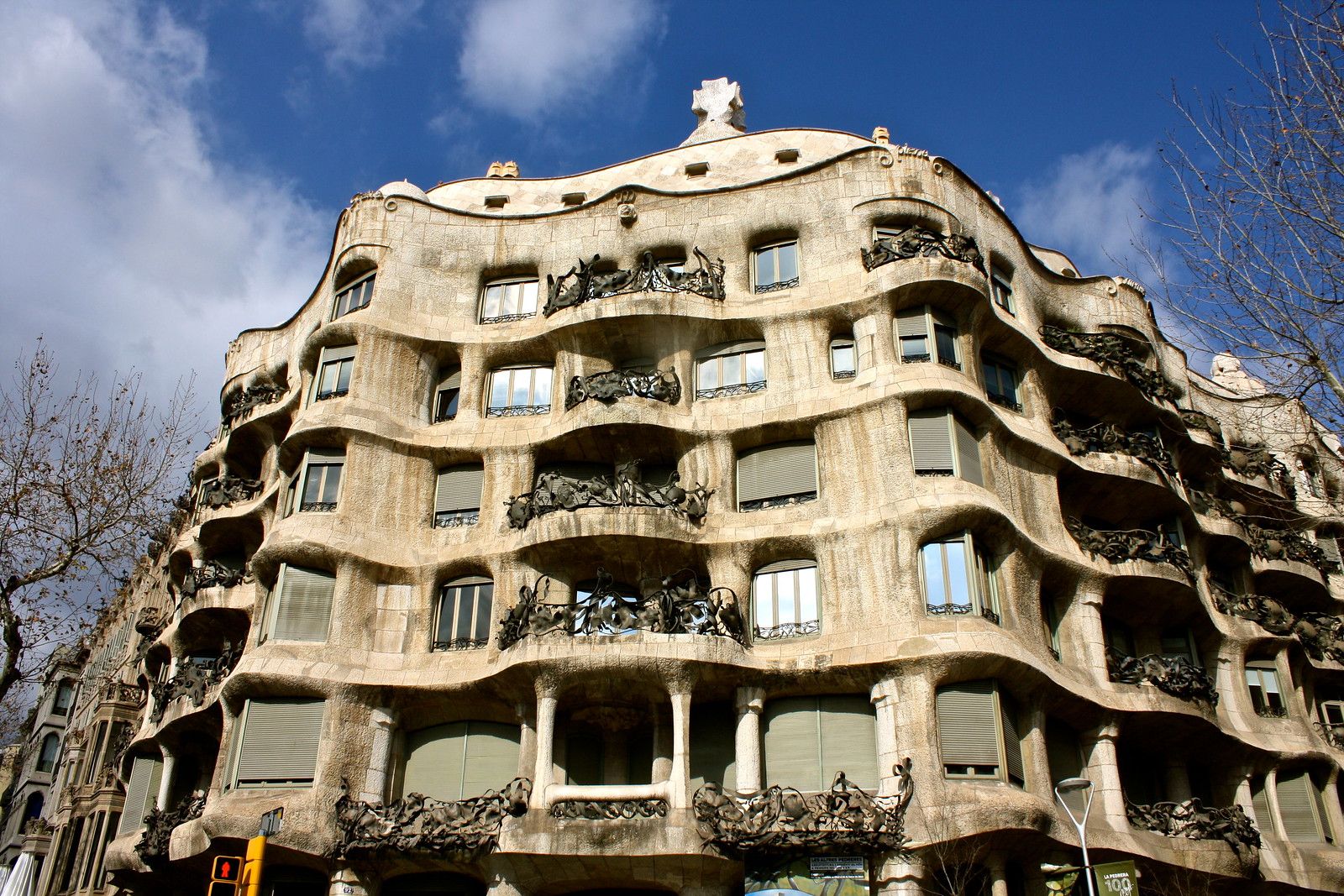Gaudí Week #4: Casa Milà, a.k.a. “La Pedrera” in Barcelona, Spain
This week on the blog, I’m celebrating works by the famous turn-of-the-century Catalan architect Antoni Gaudí, who designed everything from churches to mansions to public parks. This post is the fourth in a seven-part series; check out the introduction here!
Between 1906 and 1912, Antoni Gaudí worked on the most distinctive apartment block on the Passeig de Gràcia, a lovely, wide north-south avenue spanning Barcelona’s Eixample district or modern, gridded “expansion.” He created a structure at the request of the industrialist Pere Milà that is actually two separate apartments joined by two oblong courtyards and an other-worldly rooftop patio with a wavy floor and weird chimneys.
It’s officially called Casa Milà, Catalan for “the Milà House,” but informally, everyone calls it La Pedrera because it looks like an open-face rock quarry. Part of the reason the wavy façade is so dramatic has to do with the street grid system that covers the Eixample; at every intersection, the corners are cut off like those desktop calendars with triangular pockets, so each street crossing is actually a little plaza and feels open and accessible.
La Pedrera houses a restored family apartment that you can stroll through wistfully and get a taste for what turn-of-the-century bourgeois Barcelona would have been like, a time of hopeful naïveté before all the tragic events of the 20th century. Up in the attic, there’s a small museum that educates you on Gaudí, his architectural style, and his building methods.
The real draw to La Pedrera, though, is the roof and its patio. The ceiling of the complex’s attic undulates like a sine curve, and the rooftop is no different. Stairs and ramps move you up and down and offer lovely views of the Passeig de Gràcia and the rest of the city. Instead of seeing chimneys as something to grudgingly put up with, Gaudí eagerly incorporated them into his design, capping them with surreal, face-like tops that look like helmet-clad stormtroopers or Pacific Islander totems. Frozen-yogurt ice cream cones tempt you to stay longer as stoic guardians keep vigil, but ultimately the whirling, spiraling patios will draw you back down to street level.
If you’ve ever been to Barcelona, did you climb up to the terrace of La Pedrera? Does this building look cheesy or intriguing to you? Comment below!
 |
| Façade of the “La Pedrera” apartment block |
Between 1906 and 1912, Antoni Gaudí worked on the most distinctive apartment block on the Passeig de Gràcia, a lovely, wide north-south avenue spanning Barcelona’s Eixample district or modern, gridded “expansion.” He created a structure at the request of the industrialist Pere Milà that is actually two separate apartments joined by two oblong courtyards and an other-worldly rooftop patio with a wavy floor and weird chimneys.
It’s officially called Casa Milà, Catalan for “the Milà House,” but informally, everyone calls it La Pedrera because it looks like an open-face rock quarry. Part of the reason the wavy façade is so dramatic has to do with the street grid system that covers the Eixample; at every intersection, the corners are cut off like those desktop calendars with triangular pockets, so each street crossing is actually a little plaza and feels open and accessible.
La Pedrera houses a restored family apartment that you can stroll through wistfully and get a taste for what turn-of-the-century bourgeois Barcelona would have been like, a time of hopeful naïveté before all the tragic events of the 20th century. Up in the attic, there’s a small museum that educates you on Gaudí, his architectural style, and his building methods.
 |
| Roof of Casa Milà |
The real draw to La Pedrera, though, is the roof and its patio. The ceiling of the complex’s attic undulates like a sine curve, and the rooftop is no different. Stairs and ramps move you up and down and offer lovely views of the Passeig de Gràcia and the rest of the city. Instead of seeing chimneys as something to grudgingly put up with, Gaudí eagerly incorporated them into his design, capping them with surreal, face-like tops that look like helmet-clad stormtroopers or Pacific Islander totems. Frozen-yogurt ice cream cones tempt you to stay longer as stoic guardians keep vigil, but ultimately the whirling, spiraling patios will draw you back down to street level.
How to get there
Casa Milà sits on the northeast corner of the intersection formed by the Passeig de Gràcia and C/ Provença in the Eixample district. Take the L3 (green line) or L5 (blue line) on the Metro and get off at the Diagonal stop.If you’ve ever been to Barcelona, did you climb up to the terrace of La Pedrera? Does this building look cheesy or intriguing to you? Comment below!